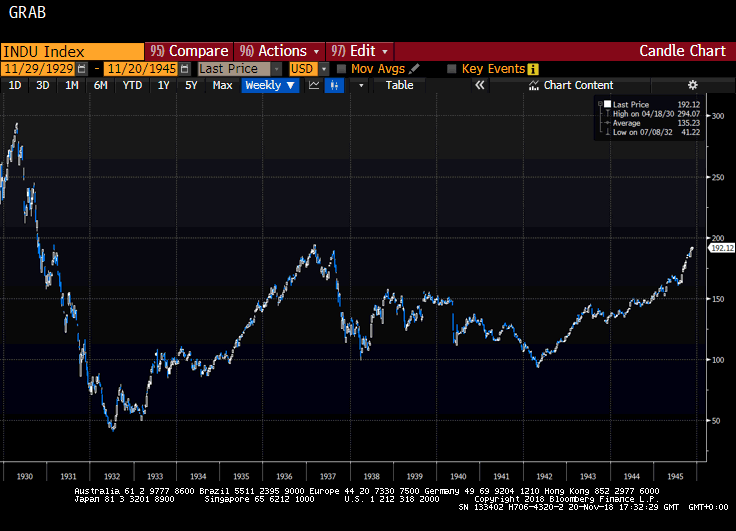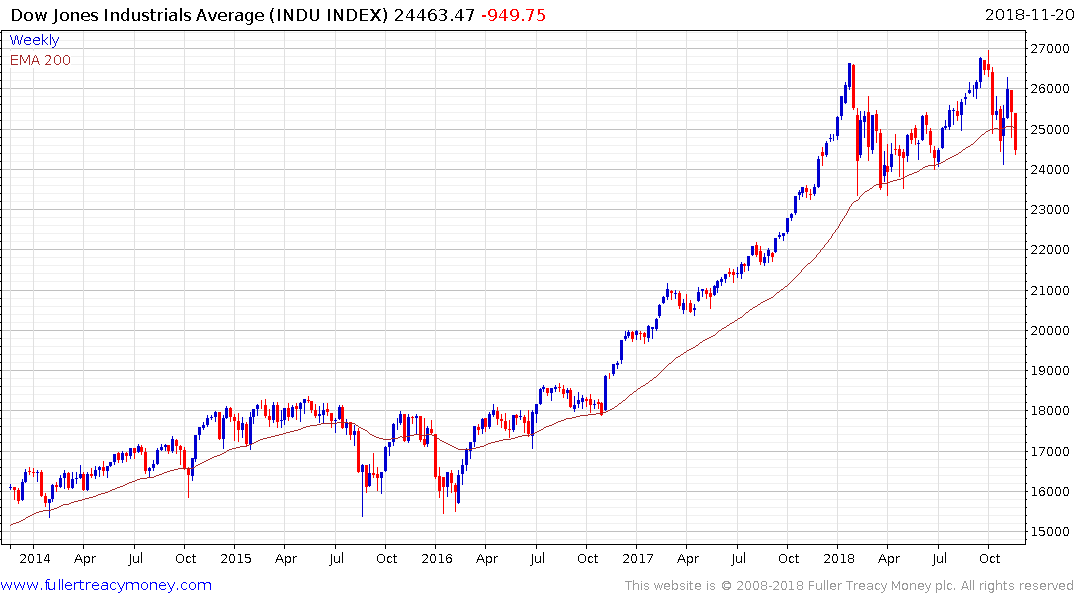Ray Dalio Discusses Major Financial Crises (Podcast)
I found this interview of Ray Dalio to be very educational and recommend it to subscribers.
Veteran subscribers who have been listening to the Long-Term audios/video over the last 18 months will be familiar with my refrain that the rise of populism is not an isolated incident but a symptom of a much wider global change where the centre is breaking.
That challenge to the status quo is resulting in demand for an alternative which is leading to an exploring of legitimacy by what once would have been considered fringe elements. The very fact people still consider this a battle between the left and right is a testimonial to how engrained centrism has become in the public discourse and how useless it is today as a narrative for evolving socio-economic conditions.
Three points Dalio makes are that he believes the closest parallel to today is 1937, the long-term debt cycle is in its 7th (of 8) innings and that expectations for future returns should be very low going forward. That begs the question what did the market do in 1937 and in the decade subsequently.
Incidentally, his Principles for Navigating Big Debt Cycles is available for free download here:
Everyone knows the Dow Jones Industrials Average peaked in 1929 and fell almost 90% to its low in 1932. It then rallied almost 300% to the 1937 peak which is what the S&P500 did following its low.

From the peak in March 1937 to the low in early 1938 the Index just about halved and spent the next seven years ranging below 150. People have to be wondering if that is what he means by those three statements.

The Dow did accelerate to its peak in January and failed to sustain its breakout to new highs in October. It returned to test the lower side of the range and has at least steadied in the region of the trend mean. As we look towards the end of the year, which is historically one of the most favourable times for shares the ability of the Average to hold its lows will be a key determinant of risk appetites.
Going through the template of six phases of a debt cycle he outlines, the clear indication is the USA is in the 6th and final phase which is “pushing on a string” because the gap between the haves and have nots has widened and money printing has not been effective in dealing with the challenges that creates. Here is a section:
Think of it this way: There are only goods and services. Financial assets are claims on them. In other words, holders of investments/assets (i.e., capitalists-investors) believe that they can convert their holdings into purchasing power to get goods and services. At the same time, workers expect to be able to exchange a unit’s worth of their contribution to the production of goods and services into buying power for goods and services. But since debt/money/ currency have no intrinsic value, the claims on them are greater than the value of what they are supposed to be able to buy, so they have to be devalued or restructured. In other words, when there are too many debt liabilities/ assets, they either have to be reduced via debt restructurings or monetized. Policy makers tend to use monetization at this stage primarily because it is stimulative rather than contractionary. But monetization simply swaps one IOU (debt) for another (newly printed money). The situation is analogous to a Ponzi scheme. Since there aren’t enough goods and services likely to be produced to back up all the IOUs, there’s a worry that people may not be willing to work in return for IOUs forever.
Low interest rates together with low premiums on risky assets pose a structural challenge for monetary policy. With Monetary Policy 1 (interest rates) and Monetary Policy 2 (QE) at their limits, the central bank has very little ability to provide stimulus through these two channels—i.e., monetary policy has little “gas in the tank.” This typically happens in the later years of the long-term debt cycle (e.g., 1937-38 and now in the US), which can lead to “pushing on a string.” When this happens, policy makers need to look beyond QE to the new forms of monetary and fiscal policy characterized by Monetary Policy 3.
Monetary Policy 3 Monetary Policy 3 puts money more directly into the hands of spenders instead of investors/savers and incentivizes them to spend it. Because wealthy people have fewer incentives to spend the incremental money and credit they get than less wealthy people, when the wealth gap is large and the economy is weak, directing spending opportunities at less wealthy people is more productive.
Logic and history show us that there is a continuum of actions to stimulate spending that have varying degrees of control to them. At one end are coordinated fiscal and monetary actions, in which fiscal policy makers provide stimulus directly through government spending or indirectly by providing incentives for nongovernment entities to spend. At the other end, the central bank can provide “helicopter money” by sending cash directly to citizens without coordination with fiscal policy makers.
Typically, though not always, there is a coordination of monetary policy and fiscal policy in a way that creates incentives for people to spend on goods and services. Central banks can also exert influence through macroprudential policies that help to shape things in ways that are similar to how fiscal policies might. For simplicity, I have organized that continuum and provided references to specific prior cases of each below.
• An increase in debt-financed fiscal spending. Sometimes this is paired with QE that buys most of the new issuance (e.g., in Japan in the 1930s, US during World War II, US and UK in the 2000s).
• Increase in debt-financed fiscal spending, where the Treasury isn’t on the hook for the debt, because: – The central bank can print money to cover debt payments (e.g., Germany in the 1930s). – The central bank can lend to entities other than the government that will use it for stimulus projects (e.g., lending to development banks in China in 2008).
• Not bothering to go through issuing debt, and instead giving newly printed money directly to the government to spend. Past cases have included printing fiat currency (e.g., in Imperial China, the American Revolution, the US Civil War, Germany in the 1930s, and the UK during World War I) or debasing hard currency (Ancient Rome, Imperial China, 16th-century England).
• Printing money and doing direct cash transfers to households (i.e., “helicopter money”). When we refer to “helicopter money,” we mean directing money into the hands of spenders (e.g., US veterans’ bonuses during the Great Depression, Imperial China).
How that money is directed could take different forms—the basic variants are either to direct the same amount to everyone or aim for some degree of helping one or more groups over others (e.g., giving money to the poor rather than to the rich). The money can be provided as a one-off or over time (perhaps as a universal basic income). All of these variants can be paired with an incentive to spend it—such as the money disappearing if it’s not spent within a year.
The money could also be directed to specific investment accounts (like retirement, education, or accounts earmarked for small-business investments) targeted toward socially desirable spending/investment. Another potential way to craft the policy is to distribute returns/ holdings from QE to households instead of to the government. • Big debt write-down accompanied by big money creation (the “year of Jubilee”) as occurred in Ancient Rome, the Great Depression, and Iceland.
There are two big conclusions from this list of alternatives. The first is that when we do get the next recession some or all of these alternatives will be deployed. That will arrest the decline in asset prices. The subsequent normalisation process represents the beginning of the debt cycle which historically has been by far the most attractive time to be long as a buy and hold investor.
In the meantime the actions of the Fed in continuing to raise interest rates into what is an increasingly uncertain environment will be a key arbiter in whether the recent lows hold.
Back to top

